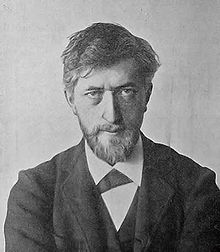81:
cool 'reflection', or perhaps more accurately cool 'calculation'. Above his outstretched right arm, there are two large figures to the left, a man in women's clothing called 'Weakness', tyrannized by a woman, an armour-clad fury called 'War'. The other giant, the one on the right, who is holding's the first one's hand, has a soft expression, he should perhaps be called 'Unsophistication' or 'Instinct', his eyes are closed. On his outstretched left art there are two large figures, a man: 'the Worker', the symbol of will and deed, and 'a Woman' who admiringly and affectionately presses the Worker's had against her throbbing heart." Around the six large figures, there are many smaller figures. They are people 'who along the way go through different states of mind such as rest, fear and suffering, moving in an anticlockwise direction, starting with 'the Worker' and finishing at life's greatest state of happiness 'the golden couple'.
77:
the middle level comes sensuality or parody, not as powerful as the first but nevertheless leaving its traces. His symbol here is a man and a woman called "the parody". The strange thing is that the woman is dressed in men's battle attire while the man is dressed in a woman's clothes. According to
Willumsen, the reaction of the opposite sex is a "quivering sensation" leaving a greater impression than the strong burst of humour at the lowest level. The third and highest level for Willumsen is aesthetic joy. To achieve it, the individual needs to have a sense of beauty.
19:
76:
In his earliest notes on the work, Willumsen explained he intended to illustrate various degrees of happiness by using different symbols. The lowest degree, which he labels tragicomical, is strong but short-lived without any lasting effects. He sees it as being symbolized by "grotesque musicians". At
80:
When presenting his work in 1928, Willumsen described it as a "collocation of figures for
Willumsen's view of existence and human life". The relief, he explained, centres on two "giants", dividing it into positive and negative parts. "One of the giants, the one on the left, is designed to represent
63:
in 1893, envisaging it as a decoration for a wall in one of the city's bars. He started working on it after returning to Paris the same year and continued its development over the next five or six years in
Copenhagen. But it was only when he had received an official commission for the work in 1920
64:
that he worked towards its completion, using a large plaster wall specially erected in his house in
Stradagervej as a base. Willumsen supervised the selection and cutting of the variously coloured pieces of
188:
60:
193:
183:
198:
93:
116:
43:
completed in 1928. Consisting mainly of marble and gilt bronze, it was included in the 2006
44:
8:
167:
147:
128:
32:
65:
48:
40:
177:
97:
18:
59:
Willumsen first thought of creating the relief when he was at the
119:, J.F. Willumsen Museum. Retrieved 8 February 2013.
175:
129:Rikke Bergmann Johansen, "Om 'Det Store Relief'"
100:, open Thursday to Sunday from 10 am to 5 pm.
17:
168:Elias Ole Tetens Lund's Trans-fænomener
176:
39:) is a sculpture by the Danish artist
143:
141:
170:with photographs of The Great Relief
22:J.F. Willumsen, photographed in 1900
13:
138:
14:
210:
161:
68:in Lazzarini's Italian workshop.
131:, Kulturkanon i undervisningen.
71:
122:
110:
1:
103:
54:
189:Sculptures by Danish artists
7:
10:
215:
154:Retrieved 8 February 2013.
135:Retrieved 8 February 2013.
150:, J.F. Willumsensmuseum.
84:
94:J.F. Willumsens Museum
36:
23:
21:
194:Danish Culture Canon
47:as a masterpiece of
45:Danish Culture Canon
184:Reliefs in Denmark
148:"Det Store Relief"
117:"The Great Relief"
61:Chicago World Fair
24:
206:
155:
153:
145:
136:
134:
126:
120:
114:
90:The Great Relief
37:Det Store Relief
28:The Great Relief
214:
213:
209:
208:
207:
205:
204:
203:
199:1928 sculptures
174:
173:
164:
159:
158:
151:
146:
139:
132:
127:
123:
115:
111:
106:
92:can be seen in
87:
74:
57:
12:
11:
5:
212:
202:
201:
196:
191:
186:
172:
171:
163:
162:External links
160:
157:
156:
137:
121:
108:
107:
105:
102:
86:
83:
73:
70:
66:Carrara marble
56:
53:
49:Danish culture
41:J.F. Willumsen
9:
6:
4:
3:
2:
211:
200:
197:
195:
192:
190:
187:
185:
182:
181:
179:
169:
166:
165:
149:
144:
142:
130:
125:
118:
113:
109:
101:
99:
98:Frederikssund
95:
91:
82:
78:
72:The sculpture
69:
67:
62:
52:
50:
46:
42:
38:
34:
30:
29:
20:
16:
124:
112:
89:
88:
79:
75:
58:
27:
26:
25:
15:
152:(in Danish)
133:(in Danish)
178:Categories
104:References
55:Background
85:Museum
33:Danish
96:in
180::
140:^
51:.
35::
31:(
Text is available under the Creative Commons Attribution-ShareAlike License. Additional terms may apply.
